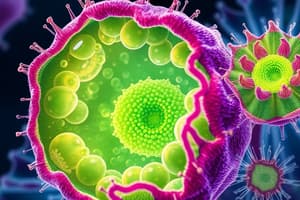Podcast
Questions and Answers
Which of the following cell types is primarily responsible for photosynthesis in plants?
Which of the following cell types is primarily responsible for photosynthesis in plants?
- Epidermis
- Sclerenchyma
- Collenchyma
- Parenchyma (correct)
What is the primary function of collenchyma cells in plant tissues?
What is the primary function of collenchyma cells in plant tissues?
- Protecting the plant from herbivores
- Storage of nutrients
- Providing flexible support to surrounding tissues (correct)
- Transport of water and minerals
Which cell type is characterized by its role in tissue repair and replacement?
Which cell type is characterized by its role in tissue repair and replacement?
- Sclerenchyma
- Parenchyma (correct)
- Xylem
- Collenchyma
A botanist discovers a new plant species in a harsh, windy environment. Analysis reveals an abundance of which cell type, providing both strength and the ability to withstand bending without breaking?
A botanist discovers a new plant species in a harsh, windy environment. Analysis reveals an abundance of which cell type, providing both strength and the ability to withstand bending without breaking?
A plant physiologist is studying a mutant plant with impaired material transport. Further investigation reveals a defect in which of the following cell types, specifically affecting its ability to facilitate the movement of water and nutrients throughout the plant?
A plant physiologist is studying a mutant plant with impaired material transport. Further investigation reveals a defect in which of the following cell types, specifically affecting its ability to facilitate the movement of water and nutrients throughout the plant?
Flashcards
Parenchyma Cells
Parenchyma Cells
A type of plant cell involved in storage, photosynthesis, gas exchange, protection, and tissue repair.
Collenchyma Cells
Collenchyma Cells
A type of plant cell that provides support and flexibility to the plant, allowing for tissue repair.
Sclerenchyma Cells
Sclerenchyma Cells
A type of plant cell that provides support and assists in the transport of materials.
Parenchyma Function
Parenchyma Function
Signup and view all the flashcards
Collenchyma Function
Collenchyma Function
Signup and view all the flashcards
Study Notes
- Three types of plant cells form most plant tissues: Parenchyma, Collenchyma, and Sclerenchyma.
Parenchyma
- Storage
- Photosynthesis
- Gas exchange
- Protection
- Tissue repair and replacement
Collenchyma
- Support for surrounding tissues
- Flexibility for plant
- Tissue repair and replacement
Sclerenchyma
- Support
- Transport of materials
Studying That Suits You
Use AI to generate personalized quizzes and flashcards to suit your learning preferences.
Related Documents
Description
Plant tissues are composed of three main cell types: parenchyma, collenchyma, and sclerenchyma. Parenchyma cells are involved in storage, photosynthesis, and gas exchange. Collenchyma provides support and flexibility, while sclerenchyma offers support and facilitates material transport.



